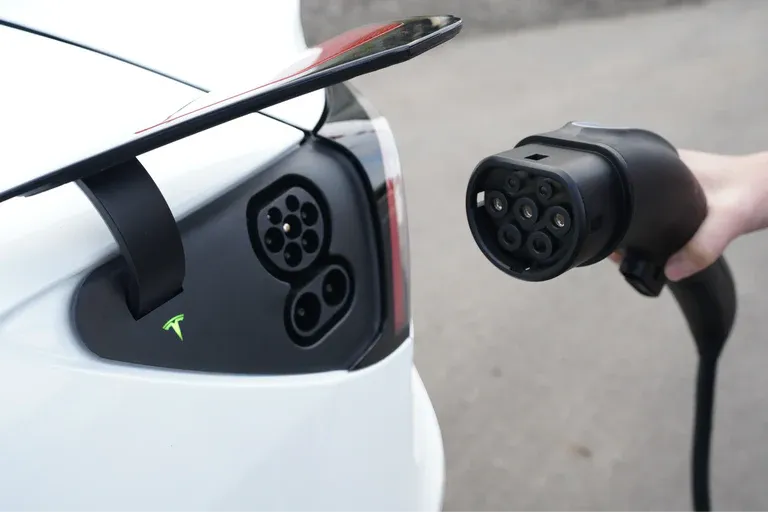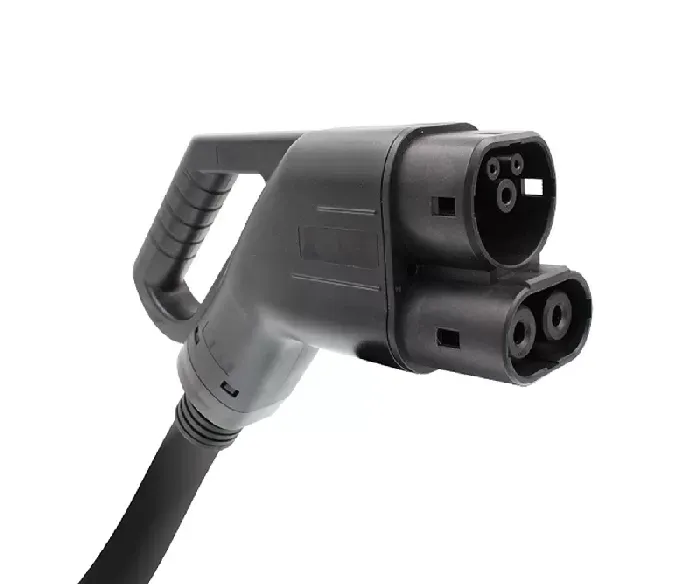In the rapidly evolving world of electric vehicles (EVs), efficient and fast charging systems are essential for keeping drivers on the road. One of the most widely used standards for fast charging in Europe is the Combined Charging System (CCS), and its latest version, the CCS2, plays a critical role in the way EV owners recharge their cars quickly and efficiently. This article explores the CCS2 charger, how it works, and compares it to its North American counterpart, the CCS1 connector.

The Combined Charging System 2 (CCS2) is a type of electric vehicle (EV) charging connector commonly used in Europe. It is part of a broader family of charging systems that provide both AC (alternating current) and DC (direct current) charging capabilities through a single port, allowing for flexible charging options depending on the infrastructure and vehicle compatibility.
CCS2, as a connector, is designed for rapid DC charging. It combines the benefits of both Type 2 AC charging (commonly used for slower, home charging) with DC fast charging capabilities. The ability to handle both AC and DC charging through a single port simplifies the EV charging process, making it more convenient and efficient for both consumers and charging networks.
The CCS2 (Combined Charging System 2) offers several key benefits for electric vehicle (EV) charging, enhancing efficiency, convenience, and accessibility:
The CCS2 system features bi-directional communication between the charger and the electric vehicle, ensuring a safer and more efficient charging process. While power is delivered unidirectionally from the charger to the vehicle, the two-way communication ensures that the correct charging levels are maintained. This prevents overcharging and optimizes battery health, providing a smoother experience for users.
One of the standout features of the CCS2 system is its universal compatibility. The connector can be used to charge EVs from various manufacturers and models, making it a highly adaptable solution. This reduces the need for multiple connectors and enhances user convenience, as drivers can easily find a compatible charging point regardless of their vehicle's brand.
The CCS2 system is designed for rapid charging, significantly reducing the time needed to recharge an EV. This is particularly advantageous for businesses looking to install charging stations, as fast charging not only attracts new visitors but also helps retain regular customers by minimizing wait times. With faster charging, EV owners can quickly get back on the road, making the system ideal for high-traffic locations.

The CCS2 connector consists of two main parts:
The upper portion of the connector includes the familiar seven pins used for Type 2 AC charging. These are used for regular, slower charging, which is typically employed at home or work using a Level 2 charger.
The lower portion of the connector features two additional larger pins that are used for rapid DC charging. These pins allow for the high power delivery required for fast charging, ensuring that EVs can recharge quickly, particularly on long journeys or at highway rest stops.
This combination of AC and DC charging makes the CCS2 connector versatile. It allows EV owners to use the same port for both everyday charging and fast, long-distance charging without the need for additional connectors or cables.
Before delving deeper into the differences between CCS1 and CCS2, it’s important to understand the counterpart of CCS2 used in North America: CCS1.
CCS1 is the standard charging connector in North America for electric vehicles. It combines the Type 1 AC charging connector (predominantly used in the United States and Canada) with additional pins for DC fast charging. The Type 1 connector is a single-phase connector, typically used for slow charging on standard home AC circuits. However, to allow for fast DC charging, the CCS1 connector adds two large pins below the Type 1 interface, enabling rapid charging at public stations.
CCS1 is primarily used in the United States and Canada, where it has become the dominant standard for both private and public charging infrastructure. With the added DC fast-charging pins, it enables EV drivers to access both slow charging (for everyday use) and rapid charging (for long-distance travel) via the same port.
Though CCS1 and CCS2 serve the same purpose — providing a unified solution for both AC and DC charging — there are some important differences between the two standards. These differences primarily stem from their physical design and technical specifications, which are influenced by the regional preferences and power delivery requirements of their respective markets.
CCS1: The CCS1 connector is based on the Type 1 plug, which is a single-phase connector used primarily in North America. This plug is widely found in residential settings, where single-phase power is commonly available. For fast DC charging, CCS1 adds two large pins below the Type 1 connector to facilitate the higher current needed for rapid charging.
CCS2: The CCS2 connector is based on the Type 2 connector, which is more versatile in terms of power delivery, supporting both single-phase and three-phase charging. This design is more suited to Europe, where three-phase power is more common, enabling higher power delivery. For DC fast charging, CCS2 integrates two additional large pins above the main AC connector, allowing it to handle both AC and DC charging seamlessly.
Both CCS1 and CCS2 connectors are capable of supporting DC fast charging, with a maximum voltage typically around 920 V. However, there are some differences in terms of current handling capacity.
CCS1 supports a maximum current of up to 200 amps, making it suitable for rapid charging but with slightly slower speeds compared to CCS2.
CCS2, on the other hand, can handle up to 350 amps, enabling faster charging speeds thanks to its more robust design and improved power delivery capability.
In theory, both connectors are capable of supporting up to 350 kW of power, enabling extremely fast charging. However, because of the higher current capacity of the CCS2 connector, it can handle faster charging times and is commonly used in ultra-fast public charging stations across Europe. This means that CCS2 can charge an EV at much higher rates, significantly reducing the amount of time spent waiting at charging stations.
CCS1 is primarily used in North America and is compatible with the public DC fast-charging networks available there, such as Tesla Superchargers (for non-Tesla EVs), EVgo, and Electrify America.
CCS2 is the dominant standard in Europe and is used in the vast majority of public charging stations across the continent, including networks like Ionity, Enel X, and Tesla Superchargers (in Europe).
The Type 2 connector, also known as the Mennekes connector, is another important element of the charging ecosystem. It is a standard for AC charging in Europe and has been widely adopted by EV manufacturers. The Type 2 connector supports both single-phase and three-phase charging, offering flexibility in terms of power delivery.
While the Type 2 connector is common in Europe, it is not as widely used in the United States. However, some EV models from Europe that have been introduced in North America, such as the BMW i3 and Audi e-tron, may use Type 2 for home or workplace charging.
|
Connector Type |
Best Use Case |
Ideal Charging Locations |
Charging Speed |
|
CCS2 |
Fast charging during long trips |
Public stations, especially along highways |
Up to 360 kW (0-80% in ~30 mins) |
|
Type 2 |
Regular AC charging for daily use |
Home or work, where extended charging time is available |
Up to 22 kW (overnight charging) |
As the table above shows, while CCS2 connectors are ideal for rapid charging during long-distance travel, Type 2 connectors are more suited for daily home charging, where the car can be plugged in overnight to recharge at a slower pace.
The CCS2 connector represents the future of electric vehicle charging in Europe, enabling both AC and DC fast charging through a single port. With its ability to deliver high charging speeds, it plays a crucial role in reducing charging times, especially for long-distance EV travel.
As more electric vehicles are sold, the availability of CCS2-compatible fast chargers will expand, further cementing the CCS2 connector’s position as the standard for EV charging in Europe. Meanwhile, North America continues to use CCS1, but the design and capabilities of CCS2 are likely to influence future developments in the region’s EV charging infrastructure as well.
By providing both slow and fast charging in a single, unified system, the Combined Charging System (CCS2) plays an essential role in enabling the widespread adoption of electric vehicles, offering drivers more convenience, flexibility, and faster charging options as the world moves toward sustainable transportation.
